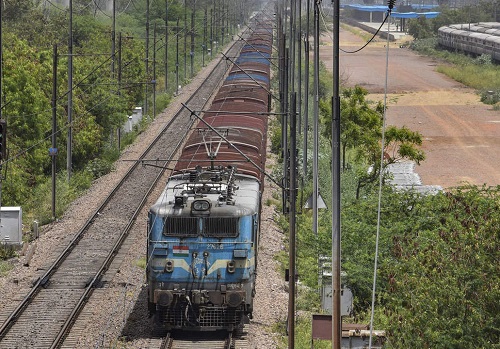Agri Picks Daily Technical Report 16 September 2021 - Geojit Financial

Follow us Now on Telegram ! Get daily 10 - 12 important updates on Business, Finance and Investment. Join our Telegram Channel
https://t.me/InvestmentGuruIndiacom
Download Telegram App before Joining the Channel
SPICES
• Spices complex on NCDEX ended on a green turf on Wednesday. Dhaniya October futures gained the most, rising more than two per cent on firm demand and fall in arrivals in the spot market. Jeera October futures to gained, however tepid demand kept gains under check. Turmeric October futures, in the meantime, pared initial losses to end the session mostly flat.
• Production of spices in India is likely to have risen 3.5% on year to 10.5 million ton in 2020-21 (Jul-Jun), according to data from Spices Board India.
• Jeera production is seen at 856,505 ton in FY 2020-21, down 6.1% on year according to the Spices Board.
• India exported 299,000 tn of jeera in 2020-21, up 40% on year according to the Spices Board.
• According to a survey conducted by the Federation of Indian Spice Stakeholders, jeera production in India is likely to be 478520 tons in 2020-21 (Oct-Sep), down by 11 per cent yoy.
• The Spices Board has pegged coriander production at 822,210 tn, up 17.3% on year.
• According to Spices Board, Coriander exports from India were up 21% on year at 57,000 ton.
• Government sees 2020-21 coriander output at 720000 tons compared to 701000 tons a year ago.
• Coriander production in Gujarat is expected to rise 55 per cent to 216680 tonnes in 2020-21 season (Jul-Jun) due to sharp rise in acreage according to the state’s farm department’s second advance estimates.
• Spices Board sees exports of turmeric up 33% to 183000 tonnes in FY 2020-21 on yoy basis.
• Government sees 2020-21 turmeric output at 1.11 million tonnes compared to 1.15 million tons a year ago.
• Spices Board pegs FY21 small cardamom export 6,500 ton, up 251% on year.
• Output of small cardamom is seen rising by 100% on year to 22520 tons according to the Spices Board.

OILSEED
• All commodities in the oilseed complex extended its correction mood. Oct RM seed prices traded lower on profit booking as lower demand at higher price levels. Oct Soybean futures fell on back of improve in supply in the spot market after government reduced effective import duties in edible oils. CPO MCX Sep traded lower on back of cut in import duties on edible oils. Oct NCDEX Refined Soy oil also traded lower on back of cut in edible oil import duty.
• The US Department of Agriculture has revised its estimate for oilseed production in 2021-22 downwards to around 629.2 mln tn from 629.5 mln tn. The reduction in estimate is due to a decline in canola production in Canada and the European Union. However, that is expected to be largely offset by higher output in Australia. Higher groundnut production in India may also offset the decline in oilseed production globally. In the September report, the agency scaled up its global soybean output view to 384.4 mln tn from the previous month's estimate of 383.6 mln tn. The global ending stocks are estimated higher by 2.7 mln tn from the previous month's estimate, at 98.9 mln tn, the agency said, citing higher beginning stocks for China and ending stocks in the US. Global soymeal import is seen at 65.24 mln tn against the earlier estimate of 64.3 mln tn because of an increase in import of geneticallymodified soymeal in India following the government's approval.
• The base import tax on crude palm oil has been slashed to 2.5% from 10%, while the tax on crude soyoil and crude sunflower oil has been reduced to 2.5% from 7.5%, the government said in a notification late on Friday. The base import tax on refined grades of palm oil, soyoil and sunflower oil cut to 32.5% from 37.5%. fter the cuts, crude palm oil, soyoil and sunflower oil imports will be subject to a 24.75% tax in total, including a 2.5% base import duty and other taxes, while refined grades of palm oil, soyoil and sunflower oil would carry a 35.75% tax in total.
• Area under soybean in the 2021-22 (Jul-Jun) kharif season was up by 0.4% on year at around 12.2 mln ha as of till now, according to data released by the farm ministry. • India's oilmeal exports plunged 27% on year to 191,188 tn in July, according to data released by the SEA. For AprJul, overall exports of oilmeal were up 10% on year at 926,833 tn. The figures for Apr-Jul were up due to higher shipments to South Korea and Thailand.
• The government allowed the import of 1.2 mln tn of genetically-modified soymeal till Oct 31 to augment supply in domestic markets, the Directorate General of Foreign Trade said in a notification.
• The government has slashed duty on import of both crude and refined soyoil and sunflower oil till Sep 30 to boost supply, according to an official notification issued. The government has cut import duty on crude soyoil and sunflower oil to 7.5% from 15%. It also slashed duty on imports of refined versions of both soyoil and sunflower oil to 37.5% from 45%, as per the notification.
• India's vegetable oil imports fell 35.4% on year to 980,624 tn in July, the Solvent Extractors' Association of India. During Nov-Jul, the country imported nearly 9.7 mln tn of vegetable oil, down 2% from the year-ago period.
• The farm ministry in its fourth advance estimates cut the output estimate of soybean crop to 12.6 mln tn from 13.4 mln tn pegged in the third advance estimates.
• India's 2020-21 (Jul-Jun) mustard output is seen rising 22.6% on year to 8.95 mln tn, according to a joint survey by the Central Organisation for Oil Industry and Trade and the Mustard Oil Producers' Association.
• India's 2020-21 (Jul-Jun) mustard output is seen rising to 22.6% on year to 8.95 mln tn, according to a joint survey by the Central Organisation for Oil Industry and Trade and the Mustard Oil Producers' Association.
• Crushing of mustard seeds by oil millers declined over 31% on year to 550,000 tn in July, data from Marudhar Trading Agency. Mills had crushed 800,000 tn of the oilseed during the same period last year, and in June this year, they crushed 600,000 tn of mustard. Low arrivals in physical markets hit crushing operations. Arrivals of the oilseed fell to almost 500,000 tn in July from 640,000 tn a year ago.
• India is likely to produce around 10 mln tn of mustard in 2020-21 (Jul-Jun), up 35% from a year ago, due to higher acreage and favourable weather conditions, according to the Solvent Extractors' Association of India.
• Indian government slashed import duty of crude palm oil. The government cut import duty on crude palm oil by 10% to 27.5%, in the last week, to cool off soaring edible oil prices in domestic markets.
• India is likely to grow a record 10 mln tn mustard crop in 2020-21 (Jul-Jun), mainly due to the likelihood of a sharp rise in acreage, according to Solvent Extractors' Association of India. The government has targeted an alltime high crop of 12.5 mln tn for this rabi season. The government has fixed the minimum support price at 4,650 rupees per 100 kg for 2020-21 (Apr-Mar) marketing season against 4,425 rupees per 100 kg the previous year.
• Malaysia's crude palm oil output rose nearly 12% on month to a little over 1.7 mln tn in August, data from the Malaysian Palm Oil Board. Total palm oil stocks in the country increased 25% on month to around 1.9 mln tn. The export of palm oil in August fell 17% on month to nearly 1.2 mln tn, while that of biodiesel rose 139% on month to 56,891 tn.
• According to data by private cargo surveyor Ampec Agri, crude palm oil exports from Malaysia for August were 10.3% lower on month at 296,566 tn.

COTTON
• The US Department of Agriculture has marginally scaled down its estimate for cotton production in India to 28.5 mln bales (1 US bale = 218 kg) in 2021-22 (Aug-Jul), from 29.0 mln bales projected a month ago. The agency has scaled up its global production estimate to 119.6 mln bales from 118.8 mln bales a month ago. The upward revision in global production estimate is mainly due to a likely bigger crop in the US, Australia and Argentina. Global cotton consumption is seen higher at 124.1 mln bales in 2021-22, versus 123.3 mln bales driven by a likely rise in demand from Pakistan, Bangladesh, Brazil, and several smaller countries. Global exports are estimated at 46.8 mln bales, higher than the earlier projection of 46.3 mln. The agency has lowered its 2021-22 global ending stocks estimate to 86.7 mln bales from 87.2 mln bales. For India, the agency maintained its domestic consumption and export estimate at 25.5 mln bales and 6.0 mln bales, respectively. Ending stocks for the country are seen at 13.8 mln bales for 2021-22 season. The average price for US upland cotton is expected to rise by 4 cents per pound to 84 cents during the current season.
• The US Department of Agriculture's Foreign Agricultural Service has marginally scaled down its estimate for cotton output in India in 2021-22 (Aug-Jul) to 28.3 mln bales (1 US bale = 218 kg) from 29.0 mln bales projected a month ago. The estimated production is up 1.4% on year, the agency said in a monthly report. The area under cotton is seen at 12.6 mln ha in 2021-22, compared with an estimated 13.0 mln ha the previous year. The average yield of cotton is expected to rise to 489 kg per ha from 467 kg last year. The fall in acreage is attributed to a reduction in area in Maharashtra, largely due to a shift to soybean due to the prevailing high prices and fear of pink bollworm infestation, according to the report. The agency has maintained its estimate for India's cotton consumption in 2021-22 at 25.5 mln bales, 6% higher on year, due to a recovery in demand. Exports during the season are seen at 6.2 mln bales. The estimate for imports into India in the 2021-22 crop year has been maintained at 1.0 mln bales. The closing stock of cotton for the country has been pegged at 13.0 mln bales, compared with 14.0 mln bales estimated the previous month.
• In the ongoing 2021-22 (Jul-Jun) season, cotton acreage across the country was 11.9 mln ha as on Thursday, down 5.8% from a year ago, data from the farm ministry showed.
• The International Cotton Advisory Committee has raised its forecast for global prices in 2021-22 (Aug-Jul) as ending stocks for the ongoing season are estimated to be lower. The committee has revised upwards its price forecast for Cotlook A Index by 3 cents from the previous month, to 98 cents per pound. In 2021-22 season, the committee has estimated global ending stocks for the season are estimated at 19.7 mln tn, compared with 20.7 mln tn in the previous season. "Higher demand compared to production is expected to cause ending stocks to decline for the second year in a row. Global consumption is projected at 25.9 mln tn, compared with 25.7 mln tn last year. While global export for the season is pegged at 10.2 mln tn. The opening of economies, activities and business has revived consumer demand for textiles and clothing. Although the spread of the COVID variants and uneven access to vaccinations in the world has kept the threat of the ongoing pandemic alive, consumption shows no signs of slowing. Global production for the ongoing season is estimated at 24.9 mln tn, compared with 24.2 mln tn in the previous season. The rise has largely been attributed to higher production in the US. In the US, cotton production is estimated at 3.8 mln tn, against 3.2 mln tn a year ago. Production in Indiais expected to be 5.9 mln tn, compared with 6.0 mln tn in the previous year.
• Cotton output in Haryana is estimated to rise by 12% on year to 2.0 mln bales (1 bale = 170 kg) in the 2021- 22 (Jul-Jun) kharif season because of higher yield. Cotton yield is seen rising to 500 kg/ha from 419 kg/ha a year ago, according to the first advance estimate shared by the senior state farm official.
• The UK-based Cotton Outlook has scaled down its estimate for global production in 2021-22 (Aug-Jul) by 40,000 tn to 25.8 mln tn, the agency said in its August report. The estimate has been revised downward as production in India is expected to be lower. The agency has pegged cotton production in India at 6.2 mln tn. Cotton output view in the US has been maintained at 3.9 mln tn. They scaled up its estimate for global consumption in 2021-22 by 5,000 tn to 26.0 mln tn owing to strong demand from China and Brazil. Global cotton ending stocks are estimated at 286,000 tn for the ongoing 2021-22 season.
• The US Department of Agriculture has scaled down its estimate for global production of cotton in 2021-22 (Aug-Jul) to 118.8 mln bales (1 US bale = 218 kg) from 119.4 mln bales projected a month ago. The downward revision in global production estimate is mainly due to a likely lower crop in the US, Brazil and Uzbekistan. In the US, production is seen at 17.3 mln bales in 2021-22 compared with 17.8 mln bales estimated earlier. Global cotton consumption is seen a tad higher at 123.3 mln bales in 2021-22, driven by a likely rise in demand from Bangladesh and Pakistan. Global exports are estimated at 46.3 mln bales, higher than the earlier projection of 45.9 mln. The agency has lowered its 2021-22 global ending stocks estimate to 87.2 mln bales from 87.7 mln bales. The output estimate for India, the top producer, is maintained at 29.0 mln bales for 2021-222. Consumption for the country is seen at 25.5 mln bales. The average price for US upland cotton is expected to rise by 5 cents per pound to 80 cents during the current season, highest since 2011-12, the agency said.
• The Cotton Association of India has scaled up its export estimate for 2020-21 (Oct-Sep) to 7.7 mln bales (1 bale = 17 kg) from 7.2 mln bales projected earlier. In the current marketing year, India shipped around 7.0 mln bales till July. The association has also raised its domestic consumption view to 33.0 mln bales, from 32.5 mln bales estimated earlier. It has lowered its ending stock estimate to 8.3 mln bales, against 9.4 mln bales. Production and import estimates for the year are seen at 35.5 mln bales and 1.0 mln bales, respectively. Production in the northern region, which includes Punjab, Haryana and Rajasthan, is seen at 6.6 mln bales. In the central zone, which includes Gujarat, Maharashtra and Madhya Pradesh, the output is estimated at 19.4 mln bales. In the southern region, production is pegged at 9.1 mln bales. Of the total crop, around 34.9 mln bales had arrived in markets across India till July.
• In the Union Budget for 2021-22 (Apr-Mar), Finance Minister Nirmala Sitharaman proposed customs duty of 5% on cotton and 10% on cotton waste. She also proposed an Agriculture Infrastructure and Development Cess of 5% on cotton, taking the overall customs duty to 10%. Customs duty on raw silk and silk yarn or yarn spun from silk waste has been increased to 15% from 10% earlier.

OTHERS
The Securities and Exchange Board of India has asked the National Commodity and Derivatives Exchange to not launch any new chana contracts on its platform till further notice, the market regulator said in a release on August 16. NCDEX has also been directed to not take any new positions for the running contracts, and only squaring up of positions will be allowed on the platform with immediate effect, according to the official release.
• Govt. procures nearly 700000 tons of chana in 2021-22 rabi marketing season
• The government exempted pulse importers from stockholding limits, but they are still required to declare their stocks on the Department of Consumer Affairs portal, an official release said. On Jul 2, the government imposed stockholding limits on pulses, barring moong, to curb the rise in prices. The limits, which were to be effective till Oct 31, had been applied on wholesalers, millers, retailers and importers. The government has also revised upwards the stockholding limits for wholesalers to 500 tn, provided there isn't more than 200 tn of one variety, the release said. The limit that had been imposed on wholesalers earlier was 200 tn, provided there was not more than 100 tn of one variety of pulse. For millers, the limit now will be the last six months of production or 50% of annual installed capacity, whichever is higher, the release said. Earlier, the limit was three months of production or 25% of annual installed capacity, whichever was higher. All the stakeholders--wholesalers, retailers, millers, and importers--are required to reduce the stocks with them to the prescribed limit within 30 days after they declare excess stocks, the release said. The government has procured 545980 tons of chana harvested in 2020-21 rabi season.
• As of 17 Aug 2021, the area under guar stood at 2012.45 thousand hectares compared to 2389.10 thousand hectares sown during the same period last year in the major growing state of Rajasthan, according to the data released by Rajasthan state agriculture department.
• According to Gujarat State farm department, area under guar stood at 1,05,704 hectares as of August 17, 2021 compared to 1,07,584 hectares during the same period last year.
• India’s guar gum exports declined in the month of June 2021 by 8.03% to 18,707 tonnes compared to 20,340 tonnes during June 2021 at an average FoB of US $ 1589 per tonne in the month of May 2021 as compared to US $ 1676 per tonne in the month of May 2021. Further, the gum shipments were up by 30.29% in June 2021 compared to the same period last year. Of the total exported quantity, around 4,152 tonnes is bought US, Russia (6,042 tonnes), Germany (1,551 tonnes) and China 1033 tonnes.
• Natural rubber traded rather steady in the Indian markets on Wednesday. RSS4 grade rubber ruled steady near Rs.174 a kg, while MCX September rubber futures ended marginally down. Uptick in natural rubber prices in the overseas market along with concerns over supply lend support.

To Read Complete Report & Disclaimer Click Here
Please refer disclaimer at www.geojit.com
SEBI Registration number is INH200000345
Views express by all participants are for information & academic purpose only. Kindly read disclaimer before referring below views. Click Here For Disclaimer























